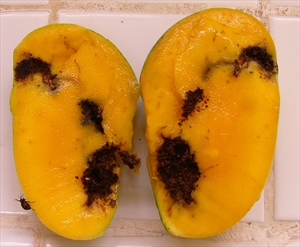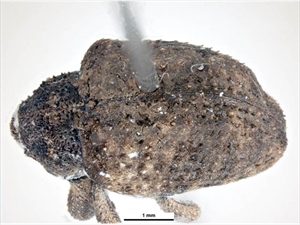- Restricted. Asia, Oceania. In Papua New Guinea.
- Serious pest causing premature fruit drop, loss of market access or the need for expensive treatments. On mango, cultivated and wild. Larvae make fruit inedible.
- Eggs laid into fruit; larvae white, legless, with black heads, tunnel through the flesh leaving trails of frass, finally pupating inside a frass-filled chamber. Adults, 6-9 cm, hard, brownish with white patches, long snouts, remaining 30 days in the fruit before leaving. Note, similarity with mango seed weevil (Sternochetus mangiferae) (see Fact Sheet no. 353) – need expert examination to separate species.
- Spread by walking and flight (strong flyer but does not go far). Spread long distances via international fruit trade, and planting material.
- Biosecurity: regulate mango imports using ‘area freedom’ as management strategy (see FAO International Standard).
- Natural enemies: Oecophylla weaver ants (see Fact Sheet no. 386).
- Cultural control: collect fallen fruit and bury deeply; harvest fruit just before ripe; bag fruits individually (use paper)when about 6 cm diameter.
- Chemical control: unlikely to be effective, but synthetic insecticides recommended in the Philippines. See recommendations for mango seed weevil (see Fact Sheet no. 353).







